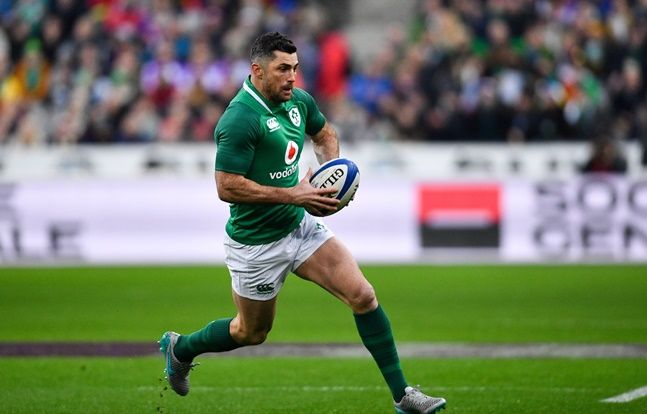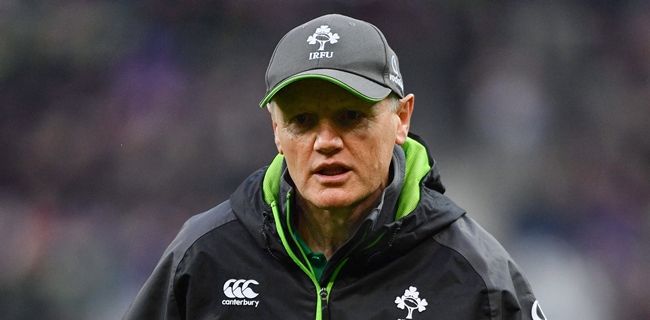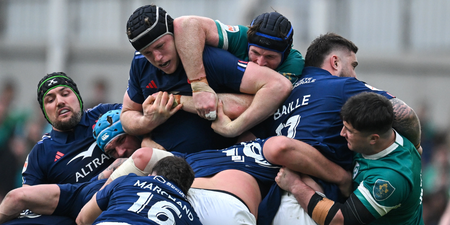Is it worth considering? In all likelihood, probably not.
Rob Kearney will almost certainly keep his place at full-back against Italy, he’s weathered worse storms before and still come through the other side with a smile and the number 15 jersey intact.
Jordan Larmour will probably be lucky to get a spot on the bench and 15 minutes at the end when Ireland are up by 25+ points, despite being the most in-form full-back, if not player, in the country.
And Joey Carbery, a player who has played just 22 minutes since November, will once again line up on the bench. That’s the most likely backline selection scenario for Ireland this weekend.
If Ireland head coach Joe Schmidt is actually going to make any changes, any changes at all for Saturday, it’s probably going to be Fergus McFadden for Jacob Stockdale, but even if that is to be the case, what’s the point? Why not let Stockdale redeem himself against an Italian side that bleeds tries?
Predicting what Schmidt will do and what he won’t do has always been two different games entirely.
Although recently, with the inclusion of Stockdale and Andrew Conway in the November series, and with James Ryan starting in Paris, he’s somewhat loosened his conservative approach towards selection.
Starting Carbery at full-back and Larmour on the wing alongside Johnny Sexton at fly-half would be a radical deviation from the norm for Schmidt, but excluding last year’s nine-try annihilation of Italy in Rome, Ireland are now averaging just one try a game in the Six Nations since the start of the 2017 championship.
Five tries across 400 plus minutes of rugby where your starting full-back has not scored a try in his last 13 tests for Ireland, or in eight games and 510 minutes for his club this season, is concerning.
You can point to French players lying all over the ball on Saturday, Nigel Owens underwhelming performance in Paris, or the tried and tested excuse of ‘conditions’, but there’s a large enough sample size to suggest that this Ireland team struggles to score tries when they are not playing against Italy, one of the very worst South African teams of all time, or an Argentinian side playing their last game of a 186,000km world tour.
Maybe that’s being too harsh, but you really have to look back to the 2016 November internationals for evidence of an Irish attack firing on all cylinders against an in-form Tier 1 nation.
Granted, you can only play what’s in front of you, but even when you look back to the 2016 Six Nations, 13 of Ireland’s 15 tries in that year’s championship came against Italy and a Gregor Townsend-less Scotland.
It could be time for a change in approach and it would not be a bad starting point to start your two most exciting attacking players alongside the best fly-half this country has ever seen.
Between Carbery and Larmour, in 21 games for Leinster this season, the pair have combined for nine tries, seven try assists, 1,151 metres, 59 beaten defenders and 24 clean breaks.
For an Ireland team that failed to break the French line once last weekend, despite boasting 68% possession, Schmidt could do worse than pick two players that have proven that they can score tries, create tries, and beat defenders at will.
Of course, Schmidt has identified these problems.
“You’re always disappointed when you’re not scoring tries, you want to be scoring tries,” said the Ireland coach after the win over France.
“I felt that the way we started the match, we looked like we might but it’s very, very difficult to put any team under pressure if the ball is slow.
“The try that the French scored with the brilliance of Teddy Thomas, it wasn’t that they had to go through too many phases which was disappointing for us, hugely disappointing.
“As soon as you went through some phases, and it was the same for the French, you were almost less likely to score a try just because the ball was slow.
“Also, I think there’s a couple of knee injuries in that game. The ground was absolutely fantastic, it was firm but it was greasy on top and as a result it was hard to get that purchase and play at a tempo that you’d like to play at.
“It’s incredibly frustrating that we let some ball escape us in the 22 and we didn’t quite create the try-scoring opportunities.”
Ireland didn’t do their cause any favours by turning the ball over multiple times in the opposition 22, but of course, to create try scoring opportunities you need to pick players who can create and score tries.
Rob Kearney is at a stage of his career where he does not look like contributing in either category, while Jacob Stockdale can certainly score tries, but his defence has come under serious scrutiny following another defensive lapse on the Thomas try.
For Schmidt to play Carbery at full-back he needs to do one of two things; firstly, he needs to cut his ties with Kearney and pick players based on form and not previous performances or experience.
Jordie Barrett, Rieko Ioane and Ngani Laumape showed that experience counts for little against the Lions last summer, never mind France or Italy, and James Ryan compounded that theory last weekend.
Kearney missed tackles, dropped balls and got smashed in the carry against France, and if it was Girvan Dempsey he was competing against you could justify his selection, but it’s not, it’s Joey Carbery, Jordan Larmour, Andrew Conway and even the ostracised Simon Zebo. Legitimate threats.
Secondly, Schmidt needs to temporarily abandon the idea that Carbery is a backup 10 at this stage of his career.
Maybe in the future when there is no Johnny Sexton at Ireland or Leinster it can garner greater consideration, and while Carbery can certainly cover the position, his best rugby has undoubtedly been played at full-back.
Plus, there’s the not so small issue that Leinster coach Leo Cullen seemingly prefers Ross Byrne over Carbery as Sexton’s deputy at Leinster. Unless that changes, is it not a long-term risk to use a player as an international backup when he may not even play his club rugby in that position?
Larmour should be given consideration regardless of whether Carbery plays or not, but if Schmidt is to continue with the physical, abrasive centre partnership of Bundee Aki and Robbie Henshaw for the rest of the tournament, he needs to include another playmaker in his side, and outside of Sexton, Carbery is Ireland’s most creative player.
Ireland assistant coach Richie Murphy revealed on Tuesday that a Sexton-Carbery 10-15 axis is a possibility that has been mooted in Irish camp.
“Definitely, it’s been considered,” said Murphy.
“When he’s sitting on the bench, he’s not only covering No 10, we know that he can slot in to ’15’ pretty easily and he’s played a lot of his rugby there. So it’s definitely something we’ve considered.”
Ireland’s attacking performance over two successive Six Nations campaign suggest that there needs to be more than just consideration of introducing a player like Carbery at full-back.
An average of one try a game with a full-back that has not scored in his last 13 games for his country suggests there needs to be action.
The introduction of Larmour would be a bonus, but the introduction of Carbery is almost imperative for a side crying out for a creative spark.


















































